Yellow badge
| Part ofa serieson |
| Antisemitism |
|---|
 |
|
|
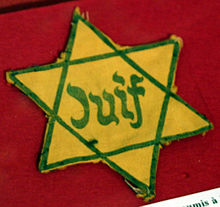
Theyellow badge,also known as theyellow patch,theJewish badge,or theyellow star(‹See Tfd›German:Judenstern,lit. 'Jew's star'), was an accessory thatJewswere required to wear in certain non-Jewish societies throughout history. A Jew's ethno-religious identity, which would be denoted by the badge, would help tomark them as an outsider.[1]Legislation that mandated Jewish subjects to wear such items has been documented in some Middle Easterncaliphatesand in some European kingdoms during themedieval periodand theearly modern period.The most recent usage of yellow badges was duringWorld War II,when Jews living inNazi GermanyandGerman-occupied Europewere ordered to wear a yellowStar of Davidto keep their Jewish identity disclosed to the public in the years leading up tothe Holocaust.
History
Muslim world
The practice of wearing special clothing or markings to distinguish Jews and other non-Muslims (dhimmis) in Muslim-dominated countries seems to have been introduced in theUmayyad Caliphateby CaliphUmar IIin the early 8th century. The practice was revived and reinforced by theAbbasidcaliphal-Mutawakkil(847–861), subsequently remaining in force for centuries.[2]Agenizahdocument from 1121 gives the following description of decrees issued in Baghdad:
Two yellow badges [are to be displayed], one on the headgear and one on the neck. Furthermore, each Jew must hang round his neck a piece of lead weighing [3 grammes] with the worddhimmion it. He also has to wear a belt round his waist. The women have to wear one red and one black shoe and have a small bell on their necks or shoes.[3]
Medieval and early modern Europe
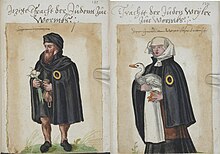
In largely Catholic Medieval Europe, Jews and Muslims were required to wear distinguishable clothing in some periods. These measures were not seen as being inconsistent with the papal bullsSicut Judaeis.Most significantly, theFourth Council of the Lateranheaded byPope Innocent IIIruled in 1215 that Jews and Muslims must wear distinguishable dress (Latinhabitus). Canon 68 reads, in part:
In some provinces a difference in dress distinguishes the Jews orSaracensfrom the Christians, but in certain others such a confusion has grown up that they cannot be distinguished by any difference. Thus it happens at times that through error Christians have relations with the women of Jews or Saracens, and Jews and Saracens with Christian women. Therefore, that they may not, under pretext of error of this sort, excuse themselves in the future for the excesses of such prohibited intercourse, we decree that such Jews and Saracens of both sexes in every Christian province and at all times shall be marked off in the eyes of the public from other peoples through the character of their dress. Particularly, since it may be read in the writings of Moses [Numbers 15:37–41], that this very law has been enjoined upon them.[4]
Innocent III had in 1199 confirmedSicut Judaeis,which was also confirmed byPope Honorius IIIin 1216. In 1219, Honorius III issued a dispensation to the Jews ofCastile,[5]the largest Jewish population in Europe. Spanish Jews normally woreturbans,which presumably met the requirement to be distinctive.[6]Elsewhere, local laws were introduced to bring the canon into effect.[7]The identifying mark varied from one country to another, and from period to period.
In 1227, theSynod of Narbonne,in canon 3, ruled:
That Jews may be distinguished from others, we decree and emphatically command that in the center of the breast (of their garments) they shall wear an oval badge, the measure of one finger in width and one half a palm in height.[4]
However, these ecclesiastic pronouncements required legal sanctions of a temporal authority. In 1228,James I of Aragonordered Jews ofAragonto wear the badge;[5]and in 1265, theSiete Partidas,a legal code enacted in Castile byAlfonso Xbut not implemented until many years later, included a requirement for Jews to wear distinguishing marks.[8]On 19 June 1269,Louis IX of Franceimposed a fine of tenlivres(one livre was equivalent to a pound of silver) on Jews found in public without a badge (Latin:rota,lit. 'wheel',French:rouelleorroue).[5][9]The enforcement of wearing the badge is repeated by local councils, with varying degrees of fines, atArles1234 and 1260,Béziers1246,Albi1254,Nîmes1284 and 1365,Avignon1326 and 1337,Rodez1336, andVanves1368.[5]The "rota" looked like a ring of white or yellow.[10]The shape and colour of the patch also varied, although the colour was usually white or yellow. Married women were often required to wear two bands of blue on their veil or head-scarf.[11]
In 1274,Edward I of Englandenacted theStatute of Jewry,which also included a requirement:
Each Jew, after he is seven years old, shall wear a distinguishing mark on his outer garment, that is to say, in the form oftwo Tables joined,of yellow felt of the length of six inches and of the breadth of three inches.[12][13]
In Europe, Jews were required to wear theJudenhutorpileum cornutum,a cone-shaped hat, in most cases yellow.[14]In 1267, theViennacity council ordered Jews to wear this type of hat rather than a badge.[5]There is a reference to a dispensation from the badge inErfurton 16 October 1294, the earliest reference to the badge in Germany.[5]There were also attempts to enforce the wearing of full-length robes, which in late 14th-centuryRomewere supposed to be red. In Portugal, a redStar of Davidwas used.[11]
Enforcement of the rules was variable; inMarseillethe magistrates ignored accusations of breaches, and in some places individuals or communities could buy exemption.Catharswho were considered "first time offenders" by theCatholic Churchand theInquisitionwere also forced to wear yellow badges, albeit in the form of crosses, about their person.
The yellow badge remained the key distinguishing mark of Jewish dress in the Middle Ages.[15]From the 16th century, the use of theJudenhutdeclined, but the badge tended to outlast it, surviving into the 18th century in places.[16]
Axis powers

AfterNazi Germany'sinvasion of Polandin 1939, there were different local decrees requiring Jews to wear a distinctive sign under theGeneral Government.The sign was a white armband with a blue Star of David on it; in theWarthegaua yellow badge in the form of a Star of David on the left side of the breast and on the back.[17]The requirement to wear the Star of David with the wordJude(German for 'Jew') – inscribed inFaux Hebrewlettersmeant to resembleHebrew writing– was then extended to all Jews over the age of six in the Reich and theProtectorate of Bohemia and Moravia(by a decree issued on 1 September 1941, signed byReinhard Heydrich)[18][19]and was gradually introduced in otherGerman-occupied areas,where local words were used (e.g.Juifin French,Joodin Dutch).
One observer reported that the star increased German non-Nazi sympathy for Jews as the impoverished citizens who wore them were, contrary toNazi propaganda,obviously not the cause of German failure on theEastern Front.In the Protectorate of Bohemia and Moravia, government had to banhat tippingtowards Jews and other courtesies that became popular as protests againstthe German occupation.Awhispering campaignthat claimed that the action was in response to the United States government requiringGerman Americansto wear swastikas was unsuccessful.[20]
Post–World War II
In May 2001, theTalibangovernment in Afghanistan ruled thatHindusin the country must wear a yellow badge, causing international outcry.[21][22]
In May 2021, in response to theanti-vaccine movementin the United States, hatWRKS, a hat store inNashville, Tennessee,sold badges that resembled the yellow stars with the words "Not vaccinated" on them. In response, theStetsoncompany announced they would no longer sell any hats to the store. This also sparked protests outside the store.[23]The practice of wearing yellow stars inprotests against responses to the COVID-19 pandemicspread to Montreal, London, Amsterdam and Paris. The practice sparked condemnation by various Jewish advocacy groups andHolocaust survivors.[24][25][26][27]
On 31 October 2023,Permanent Representative of Israel to the United NationsGilad Erdan,as well as otherIsraelidelegates, began wearing yellow star badges with the words "Never Again"written on them, in protest to criticism of Israel's conduct during the2023 Israel–Hamas war.Erdan claimed that theUN Security Councilwas "silent" about the7 October Hamas attack on Israel,and said that he would wear the star "as a symbol of pride".[28]However, this decision was immediately condemned byYad VashemchairmanDani Dayan,calling it a "[disgrace to] the victims of the Holocaust as well as the state of Israel", pointing out that the slaughter of Jews by Hamas differs from the Holocaust in that "Jews have today a state and an army. We are not defenseless and at the mercy of others."[29][30]According toYnet,unnamed officials from Israel'sMinistry of Foreign Affairswere also highly critical of the decision, with one calling it a "cheap gimmick that doesn’t serve our goal", and others describing it as an attempt to appeal toLikudparty members.[31]
Timeline
Caliphates
- 717–720
- CaliphUmar IIorders non-Muslims (dhimmi) to wear vestimentary distinctions (calledgiyār,i.e. distinguishing marks).[32]
- 847–861
- Caliphal-Mutawakkilreinforces and reissues the edict. Christians are required to wear patches. One of the patches was to be worn in front of the breast and the other on the back. They were required to be honey-coloured.[2]
- 887/888
- TheAghlabidgovernor of theEmirate of Sicilyorders Jews to wear on their garments and put on their doors a piece of cloth in the form of donkey and to wear yellow belts and special hats.[citation needed]
Medieval and early modern Europe
- 1215
- TheFourth Council of the Lateranheaded byPope Innocent IIIdeclares: "Jews andSaracensof both sexes in every Christian province and at all times shall be marked off in the eyes of the public from other peoples through the character of their dress. "[33]
- 1219
- Pope Honorius IIIissues a dispensation to the Jews ofCastile.[5]Spanish Jews normally woreturbansin any case, which presumably met the requirement to be distinctive.[6]
- 1222
- Archbishop of CanterburyStephen Langtonorders English Jews to wear a white band two fingers broad and four fingers long.[5]
- 1227
- The Synod ofNarbonnerules: "That Jews may be distinguished from others, we decree and emphatically command that in the center of the breast (of their garments) they shall wear an oval badge, the measure of one finger in width and one half a palm in height."[33]
- 1228
- James Iorders Jews ofAragonto wear the badge.[5]
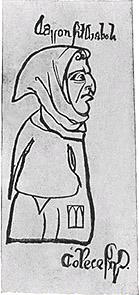
In the 1277 caricatureAaron, Son of the Devil,Aaron wears a badge with theTablets of the Law - 1265
- TheSiete Partidas,a legal code enacted in Castile byAlfonso Xbut not implemented until many years later, includes a requirement for Jews to wear distinguishing marks.[8]
- 1267
- In a special session, theViennacity council forces Jews to wearpileum cornutum(a cone-shaped head dress, common in medieval illustrations of Jews); a badge does not seem to have been worn in Austria.[5]
- 1269
- France.(Saint)Louis IX of Franceorders all Jews found in public without a badge (French:rouelleorroue,Latin:rota) to be fined ten livres of silver.[9]The enforcement of wearing the badge is repeated by local councils, with varying degrees of fines, atArles1234 and 1260,Béziers1246,Albi1254,Nîmes1284 and 1365,Avignon1326 and 1337,Rodez1336, andVanves1368.[5]
- 1274
- TheStatute of Jewryin England, enacted by KingEdward I,enforces the regulations. "Each Jew, after he is seven years old, shall wear a distinguishing mark on his outer garment, that is to say, in the form of two Tables joined, of yellow felt of the length of six inches and of the breadth of three inches."[13]
- 1294
- Erfurt.The earliest mention of the badge in Germany.[5]
- 1315–1326
- EmirIsmail Abu-I-Walidforces the Jews ofGranadato wear the yellow badge.[5]
- 1321
- Henry II of Castileforces the Jews to wear the yellow badge.[5]
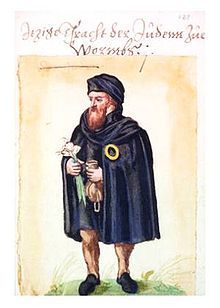
16th-century watercolour of a Jew from Worms, Germany. TherotaorJewish ringon the cloak, moneybag, and garlic bulb are symbols ofantisemitic ethnic stereotypes - 1415
- A bull of theAntipope Benedict XIIIorders the Jews to wear a yellow and red badge; the men on their breast, the women on their forehead.[5]
- 1434
- EmperorSigismundreintroduces the badge atAugsburg.[5]
- 1528
- TheCouncil of TenofVeniceallows the newly arrived famous physician and professorJacob Mantino ben Samuelto wear the regular black doctors' cap instead of Jewish yellow hat for several months (subsequently made permanent), upon the recommendation of the French and English ambassadors, thepapal legate,and other dignitaries numbered among his patients.[34]
- 1555
- Pope Paul IVdecrees, in hisCum nimis absurdum,that the Jews should wear yellow hats.
- 1566
- KingSigismund IIpasses a law that requiredLithuanianJews to wear yellow hats and head coverings. The law was abolished twenty years later.[5]
- 1710
- Frederick William Iabolished the mandatory Jewish yellow patch inPrussiain return for a payment of 8,000thaler(about $75,000 worth of silver at 2007 prices) each.[35]
Axis powers
1939
- Local German occupation commanders ordered Jewish Poles to wear an identifying mark under the threat of death. There were no consistent requirements as to its colour and shape: it varies from a white armband, a yellow hat to a yellow Star of David badge.Hans Frankordered all Jewish Poles over the age of 11 years inGerman-occupied Polandto wear white armbands with a blue Star of David.
1940
- A popular legend portrays kingChristian X of Denmarkwearing the yellow badge on his daily morning horseback ride through the streets ofCopenhagen,followed by non-Jewish Danes responding to their king's example, thus preventing the Germans from identifying Jewish citizens. QueenMargrethe II of Denmarkhas explained that the story was not true.[36][37]No order requiring Jews to wear identifying marks was ever introduced in Denmark.[38]
1941
- Jews in theIndependent State of Croatia,a puppet state of Nazi Germany, are ordered to wear "Jewish insignia".[39]Jewish Poles in German-occupiedSoviet-annexed Poland,Jewish Lithuanians, Latvians and Estonians as well as Soviet Jews in German-occupied areas were obliged to wear white armbands or yellow badges. All Romanian Jews were ordered to wear the yellow badge.[40]The yellow badge was the only standardised identifying mark in the German-occupied East; other signs were forbidden. Jewish Germans and Jews with citizenship of annexed states (Austrians, Czechs, Danzigers) from the age of six years were ordered to wear the yellow badge from 19 September when in public.[18]In Luxembourg, the German occupation authorities introduce theNuremberg Laws,followed by several other anti-Jewish ordinances including an order for all Jews to wear a yellow star with the word "Jude".[41]TheSlovak Republicordered its Jews to wear yellow badges.
- 1941/1942
- Romaniastarted to force Jews in newly annexed territories, denied Romanian citizenship, to wear the yellow badge.
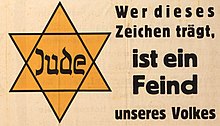
"Whoever wears this sign is an enemy of our people" –Parole der Woche,1 July 1942
1942
- TheGestapoordered Jewish Germans and Jews with citizenship of annexed states to mark their apartments or houses at the front door with a white badge.[42]Jewish Dutch people ordered to wear the yellow badge. Jewish Belgians ordered to wear the yellow badge. Jews inoccupied France,covering the northern and western half of the country, were ordered to wear a yellow star by the German authorities. Bulgaria ordered its Jewish citizens to wear small yellow buttons. German forces invaded and occupied thezone libre,i.e. the south-eastern half of France, but did not enforce the yellow star directive there.
1944
- After the occupation ofHungary,the Nazi occupiers ordered Jewish Hungarians and Jews with defunct other citizenships (Czechoslovak, Romanian, Yugoslav) in Hungarian-annexed areas to wear the yellow badge.[43]
See also
- Antisemitism in Christianity
- Antisemitism in Islam
- Cathar yellow cross
- History of antisemitism
- Jewish visibility
- Nazi concentration camp badge
References
- ^D'Ancona, Jacob(2003).The City of Light: The Hidden Journal of the Man Who Entered China Four Years Before Marco Polo.Translated bySelbourne, David.New York: Citadel Press. pp. 23–24.ISBN0-8065-2463-4.
But the wearing of a badge or outward sign – whose effect, intended or otherwise, successful or not, was to shame and to make vulnerable as well as to distinguish the wearer – was one thing.
- ^abBell, Dean Phillip (2005)."Yellow Badge".InLevy, Richard S.(ed.).Antisemitism: A Historical Encyclopedia of Prejudice and Persecution.Vol. 1. Santa Barbara, California: ABC-Clio. p. 779.ISBN1-85109-439-3.
- ^Johnson, Paul(1987).A History of the Jews.New York: Harper & Row. pp. 204–205.ISBN978-0-06-015698-5.
- ^abHalsall, Paul, ed. (March 1996)."Twelfth Ecumenical Council: Lateran IV 1215".Internet Medieval Sourcebook.Retrieved13 July2023– viaInternet History Sourcebooks Project.
- ^abcdefghijklmnopqAdler, Cyrus;Jacobs, Joseph(1902)."BADGE".InSinger, Isidore(ed.).The Jewish Encyclopedia.Vol. II. New York; London: Funk & Wagnalls. pp. 425–427.Retrieved13 July2023.
- ^abRoth, Norman."Jewish Clothing in the Middle Ages".My Jewish Learning.Retrieved13 July2023.
- ^Schreckenberg, Heinz (1996).The Jews in Christian Art: An Illustrated History.New York: Continuum. pp. 15 and passim.ISBN0-8264-0936-9.
- ^abHalsall, Paul, ed. (October 1997)."Las Siete Partidas: Laws on Jews, 1265".Internet Medieval Sourcebook.Retrieved18 September2006– viaInternet History Sourcebooks Project.
- ^abBirnbaum, Eli."This Day in Jewish History".The Jerusalem Post.Archived fromthe originalon 19 May 2006.Retrieved9 August2006.
- ^Schreckenberg 1996,p. 15, althoughPiponnier & Mane 1997,p. 137, say red was commonest for badges of all shapes, followed by yellow or green, or red and white together.
- ^abPiponnier, Françoise; Mane, Perrine (1997).Dress in the Middle Ages.Translated by Beamish, Caroline. New Haven: Yale University Press. p. 137.ISBN0-300-06906-5.
- ^Schreckenberg 1996,p. 305.
- ^ab"A Day in the Life of 13th-Century England".This Sceptred Isle.BBC Radio 4.Retrieved5 September2006.
- ^Yoked, Tzach (21 April 2023)."How European Jews Were Labeled, Centuries Before the Yellow Star".Haaretz.Retrieved13 July2023.
- ^Schreckenberg 1996,p. 15, althoughThe Jewish Encyclopediacites a reference from 1208 in France. SeeThe Jewish Encyclopediafor theJudenhutbeing more widespread than the badge.
- ^Schreckenberg 1996,pp. 308–329.
- ^"JEWISH BADGE".Museum of Tolerance Multimedia Learning Center.Simon Wiesenthal Center.Archived fromthe originalon 12 February 2008.Retrieved13 July2023.
- ^ab"Polizeiverordnung über die Kennzeichnung der Juden".Verfassungen der Welt(in German). 1 September 1941. Archived fromthe originalon 22 July 2011.Retrieved13 July2023.
- ^Robertson, Struan."I. Buildings Integral to the Former Life and/or Persecution of Jews in Hamburg - Neustadt/St. Pauli. | 23. No. 35 Karolinenstraße".rrz.uni-hamburg.de.Regional Computing Center,University of Hamburg.Archived fromthe originalon 12 November 2005.Retrieved13 July2023.
- ^Smith, Howard K.(1942).Last Train from Berlin.New York: Alfred A. Knopf. pp. 195–199, 203–204.
- ^"rediff.com US edition: US lawmakers say 'We are Hindus'".www.rediff.com.Retrieved17 October2023.
- ^Harding, Luke; correspondent, south Asia (24 May 2001)."Taliban defends Hindu badges plan".The Guardian.ISSN0261-3077.Retrieved17 October2023.
{{cite news}}:|last2=has generic name (help) - ^Alonso, Melissa; Rose, Andy (29 May 2021)."Demonstrators gather outside Nashville hat store that offered 'not vaccinated' yellow Star of David badges".CNN.Retrieved30 May2021.
- ^Thomas, Katelyn (19 August 2021)."Jewish groups, minister condemn yellow stars worn by anti-vaccine protesters".Montreal Gazette.Retrieved12 September2021.
- ^"More than 20,000 people took part in Amsterdam march, officials say".DutchNews.6 September 2021.Retrieved12 September2021.
- ^"German call to ban 'Jewish star' at Covid demos".BBC News.7 May 2021.Retrieved12 September2021.
- ^Gouvy, Constantin; Charlton, Angela (19 July 2021)."Anger as French protesters compare vaccines to Nazi horrors".Associated Press.Retrieved12 September2021.
- ^"Israel's UN delegates criticised for wearing yellow stars as 'symbol of pride'".Reuters.31 October 2023.Retrieved26 November2023.
- ^"Yad Vashem, Israeli officials react harshly to UN chief remarks on Oct 7 massacre".i24 News.25 October 2023.
- ^"Israel envoy wears yellow star at UN, drawing Yad Vashem criticism".France 24.AFP. 31 October 2023.Retrieved26 November2023.
- ^Magid, Jacob."Erdan tells UN he'll don yellow Star of David until it condemns Hamas; Yad Vashem fumes".The Times of Israel.AFP.
- ^Heinemann, Isaak (1974).Antisemitism.Keter Books. p. 84.ISBN978-0-7065-1327-1.
- ^abFourth Council of the Lateran,Canon 68.
- ^Deutsch, Gotthard;Broydé, Isaac(1904)."MANTINO, JACOB BEN SAMUEL".InSinger, Isidore(ed.).The Jewish Encyclopedia.Vol. VIII. New York; London: Funk & Wagnalls. pp. 297–298.Retrieved13 July2023.
- ^Elon, Amos(2002).The Pity of It All: A History of the Jews in Germany, 1743–1933.New York: Metropolitan Books. p. 15.ISBN0-8050-5964-4.See talk page for conversion.
- ^Wolden-Ræthinge, Anne(1990).Queen in Denmark.Copenhagen: Gyldendal.ISBN87-01-08623-5.[page needed]
- ^"Did King Christian X of Denmark wear a yellow star in support of the Danish Jews?".Holocaust Encyclopedia.Retrieved17 August2006.
- ^Paulsson, Gunnar S.(July 1995). "The 'Bridge over the Øresund': The Historiography on the Expulsion of the Jews from Nazi-Occupied Denmark".Journal of Contemporary History.30(3): 431–464.doi:10.1177/002200949503000304.JSTOR261157.S2CID162324125.
- ^"Notice regarding the obligatory wearing of Jewish insignia and the marking of Jewish trades, stores and companies".jusp-jasenovac.hr.Jasenovac Memorial Site. 17 June 1941.Retrieved16 January2014.
- ^Evans, Richard J.(2008).The Third Reich at War.New York: Penguin Books. p. 231.ISBN978-0-14-311671-4.
- ^Webb, Chris (2010)."The Destruction of the Jews of Luxembourg".HolocaustResearchProject.org.Holocaust Education & Archive Research Team.Retrieved15 March2018.
- ^Benz, Wolfgang,ed. (1988).Die Juden in Deutschland, 1933–1945: Leben unter nationalsozialistischer Herrschaft(in German). Munich: C. H. Beck. pp. 618seq.ISBN3-406-33324-9.
- ^Evans 2008,p. 616.
External links
- Distinctive Badges that Jews Were Forced to Wear During the Holocaust–Yad Vashemwebsite
- The Jewish Badgeat ThoughtCo
- Yellow Badge in Art
- A Yellow Star of David Button, Which the Bulgarian Jews were Forced to Wear in 1941 with the Onset of the German Occupationfrom the Yad Vashem artifacts collection
- "Wear It With Pride, The Yellow Badge" by Robert WeltschJüdische Rundschau,No. 27, 4 April 1933
Denmark: The king against the yellow badge
